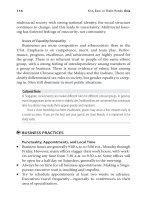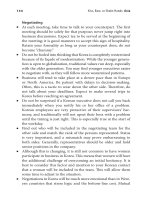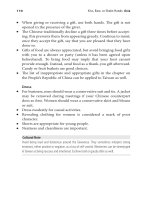How to Understand Business Finance Understand the Business Cycle Manage Your Assets Measure Business Performance Sunday Times Creating Success_3 potx
Bạn đang xem bản rút gọn của tài liệu. Xem và tải ngay bản đầy đủ của tài liệu tại đây (186.36 KB, 18 trang )
44 How to Understand Business Finance
Table 2.14 February balance sheet
£000s £000s
Assets (What we have)
Current assets:
Cash 4
Owed by customers (debtors/receivables) 67
Stocks (inventories) 0
Total current assets (A)
71
Current liabilities:
Credit from suppliers
(creditors/payables) (B)
(12)
Net working capital (A–B)
59
Fixed assets:
Equipment 5
NET ASSETS
64
Capital employed: (where it came from)
Bank Loans
20
Owners’ equity
Share capital 30
Retained earnings (or losses) to date 14
Total equity
44
CAPITAL EMPLOYED
64
3
Where do all the business
functions fi t in?
While an understanding of the main fi nancial accounts is of
interest to business managers and fi nancial analysts, if you work
in one of the functions you could be asking yourself, ‘Where do I
fi t into this?’ The aim of this chapter is to show how each function
is linked to the fi nancial performance of the business, and how
each can make its own contribution to fi nancial health – we all
have a part to play.
Sales
Sales teams obviously have an eye on the ‘top line’, ie sales
generation. It is important to recognise the diff erence between sales
volume (units sold) and sales revenue (monetary value). Salespeople
frequently have no idea of the costs to provide the products and
services they have sold and hence no idea of how profi table this
piece of business will be. Sales bonuses based on profi t rather than
volume clearly motivate salespeople to understand this better!
Another area to watch out for is the discounts and
commissions which may be off ered. While these are variable
45
46 How to Understand Business Finance
‘costs’ (ie if you don’t make the sale you don’t incur the cost), the
impact they can have will be dependent on the dynamic of the
business (see Chapter 11).
Giving discounts for volume is a very slippery slope. Let’s
imagine a salesperson is with a customer, and that
customer demands a price cut – not requests, you
understand, but demands, ‘Five per cent or there’s no
order’. She is, however, an understanding customer, and she
knows that the salesperson will want something in return,
so off ers him some extra business. The question for the
salesperson is: how much more volume is required if profi t
is not to go down?
The problem here is that most salespeople don’t know the
relationship between volume and profi t, for one of two reasons:
they don’t know how to work it out; or even if they do know how,
they don’t have the necessary data to hand.
So what is it – 5 per cent more volume, 25 per cent, 50 per
cent? The answer depends on what level of margin you were
making in the fi rst place. Table 3.1 illustrates this relationship
between margin, discounts, and volume.
Example: if a business making a 25 per cent profi t margin
gives a volume discount of 7.5 per cent, a 43 per cent volume
increase is required to make the same profi t. (This calculation
doesn’t take account of any resulting economies of scale, or of the
notion of marginal pricing and ‘contribution to overheads’, but
even so, the fi gures are rather arresting.)
Table 3.1 is interesting, but remember that even if you have it
to hand, if you don’t know your margins in the fi rst place it is not
of much help.
47 Where do all the Business Functions Fit in?
Table 3.1 The percentage volume increase required to maintain
profi t, for discounts given
Discount
given
Current % profi t margin
10 15 20 25 30 35 40 50
2% 25 15 11 9 7 6 5 4
3% 43 25 18 14 11 9 8 6
4% 67 36 25 19 15 13 11 9
5% 100 50 33 25 20 17 14 11
7.5% 300 100 60 43 33 27 23 18
10% 200 100 67 50 40 33 25
15% 300 150 100 60 43 33
20% 400 300 133 100 66
Note: The fi gures in the main part of the table (shown in normal type) are the percentage
increases in volume required for profi ts to stand still if a discount is given as shown in the left
hand column, while the current profi t margin is shown along the top row.
Know your margins
There are two main reasons why salespeople don’t know their
company’s margins: their business systems are not able to
measure margins with accuracy down to customer level; or the
measurements are made, but the salespeople are not trusted with
the information, for fear that they will tell the customer.
The dialogue between sales and fi nance has to improve such
that accountants know why the need to measure margins at
customer level is so important, and so that accountants can trust
salespeople with this very sensitive information.
48 How to Understand Business Finance
The tale of ‘spreading jam’
A common problem is the way that businesses ‘spread’ their
overhead costs across customers: that is, they spread them evenly,
irrespective of the actual costs involved in dealing with diff erent
customers. They do the same when looking at product profi tability,
even at diff erent business units – a laziness equally damaging to
decision making. Take the following example of a company that
talked itself out of business because of such ‘jam spreading’.
The company has four customers, shown in Table 3.2: a profi t
in total, but the ‘spreading’ of overheads indicates a loss-making
customer – customer D. The decision is taken to cease doing
business with that customer. Unfortunately, overheads do not
reduce immediately by the 60 that had been allocated to customer
D, but they do go down by 30, and people give themselves a slap
on the back for a smart decision.
Table 3.3 shows the new picture: the company is still in profi t,
but customer C is now a loss-making customer, and the troubled
board meet to decide action. ‘Concentrate on profi table
customers’, they say, and customer C is quietly dropped, but
unfortunately, the overheads do not reduce in line. Table 3.4
shows the results of this move.
Perhaps you can guess what happened next.
The solution to this problem lies in some form of activity-
based costing, where the costs of activities, people, overheads etc
are allocated more precisely to individual customers. Businesses
Table 3.2 Consequences of ‘spreading’ overheads evenly – Customer D
Customer
A
Customer
B
Customer
C
Customer
D
Company
total
Gross profi t 100 80 60 50 290
Overheads 60 60 60 60 240
Net profi t 40 20 0 –10 50
49 Where do all the Business Functions Fit in?
Table 3.3 Consequences of ‘spreading’ overheads evenly – Customer C
Customer
A
Customer
B
Customer
C
Customer
D
Company
total
Gross profi t 100 80 60 xxxx 240
Overheads 70 70 70 xxxx 210
Net profi t 30 10 –10 xxxx 30
Table 3.4 Further consequences of ‘spreading’ overheads evenly
Customer
A
Customer
B
Customer
C
Customer
D
Company
total
Gross profi t 100 80 xxxx xxxx 180
Overheads 90 90 xxxx xxxx 180
Net profi t 10 –10 xxxx xxxx 0
such as management consultancies, advertising agencies and
legal practices will do this to some degree. What these companies
sell is their experts’ time, and so that time must be monitored and
charged. The outcome is a business that knows where its profi ts
come from, and so managers are better able to make decisions
concerning key accounts.
Marketing
While sales is about present business, marketing is about the future.
Here we fi nd we are in uncharted territory. Marketers tend to think
too much in terms of the P&L account, forgetting that developing
and launching new products can have a major impact on production
assets, stock, credit from suppliers, increased debtors etc.
50 How to Understand Business Finance
In one case, a product manager enthused over a new
product launch because he had calculated that it would
make splendid margins, resulting in a very handsome
P&L. Unfortunately, the long lead times for development,
the huge demands on colleagues’ time to get the project
up and running and the massive building of stock in
preparation for launch brought the company to its knees
before it was able to invoice its fi rst customer.
As well as considering these factors it may be appropriate to
model possible marketing scenarios using tools such as
discounted cash fl ow, net present value, and payback
mentioned later in this book. In other words, to think of
marketing activities as business projects with an initial
investment and then subsequent income once the marketing
has been implemented.
Manufacturing
Anyone who has been in production knows how accountants
make people slaves to the budget. The biggest problem with
budgets is that they are normally set at the end of the previous
year, based on last year’s costs. This sometimes bears no
resemblance to what you actually end up manufacturing.
To overcome this problem, accountants invented ‘standard
costings’. The concept is based on devising what the ideal costs
are for manufacturing each product you make. This includes an
element of fi xed costs as well as variable costs (see Chapter 11).
Good in theory, but in practice we may manufacture it on diff erent
machinery, using diff erent raw materials, in diff erent batch sizes
etc, never minding that we might have problems with the
manufacturing process itself.
51 Where do all the Business Functions Fit in?
To compound this, some companies then introduce this
standard costing into their management accounts. This means they
value stock at the standard cost, which includes some fi xed costs.
When the product is sold, the value of this stock is taken across
into the P&L account as normal, as part of the ‘cost of goods sold’.
Fixed costs are also charged on the profi t and loss account as
they occur. This gives rise to a problem: we are in danger of double
counting because there is also an element of fi xed costs in the
standard costings. Accountants remedy this by introducing
‘recoveries’. This is the amount of fi xed costs included in the
standard costing of the goods sold in that accounting period.
All this confuses what is actually going on in the accounts to
such an extent that you often don’t know what’s happening in the
business! As you can guess, I am not a fan of standard costings
except as a mechanism to ensure we monitor our manufacturing
costs against some benchmark.
Clearly, manufacturing has a major impact on the accounts in
terms of variable costs (raw materials, packaging, plant
effi ciencies etc) and fi xed costs (direct expenses associated with
production), and thus the profi tability of the business.
Supply chain management
Supply chain managers have an impact on all stages of the
production and sale of goods and services. Listed below are just a
few examples:
raw materials costs, location and size of stocks and •
supplier payment terms;
location of each phase of production, size and location of •
stocks of intermediate products, transfer pricing and
local tax payments;
choice of packaging and transportation;•
distribution channels, commissions, rebates etc;•
outsourcing, toll manufacture and subcontracting •
elements of manufacturing.
52 How to Understand Business Finance
All of these clearly have implications for variable and fi xed costs,
working capital and tax – in other words, the overall profi tability
of the business.
Human resources
Without the right people with appropriate skills and experience,
our business cannot thrive. And yet we know that while we are
told that people are our most valuable asset, they do not appear in
the accounts except as a cost.
To make sure that we do not have additional unplanned costs
for our staff , we need to have well-defi ned terms and conditions of
employment, so that employees do not expect that the
organisation will pay unplanned expenses. This can also be
important when we second staff overseas, or have to terminate
their employment.
Accountants will also view costs like training and development
as optional expenses. These are often the fi rst to be cut in diffi cult
times. It is worth considering the impact that these activities have
on the ability of your business to retain its staff . Recruitment and
training is both costly and time-consuming, any savings must be
compared with the costs and impact of recruiting, training and
using new and inexperienced staff , which can be very great.
IT, maintenance and engineering
Nobody likes being lumped into ‘support services’ but IT,
maintenance and engineering have similarities regarding their
impact on fi nance. First, they are all seen as fi xed costs to be
managed.
All these activities are involved in purchasing new assets. It
should not be forgotten that when you purchase fi xed assets (plant
and equipment) which have a useful life spanning more than one
year, they should be put on the balance sheet as a capital item.
This means that the total cost of these assets is removed from the
53 Where do all the Business Functions Fit in?
P&L account. Admittedly these assets are then depreciated, and
this will impact on the profi t (see Chapter 10). It is possible to
suspend depreciation if an asset is mothballed, but your
accountants will have a view on the prudence of such an action.
When undertaking projects whose eff ective life spans more
than one year, you can think about capitalising the project costs
and amortising them over the project’s life (see Chapter 10). This
has the eff ect of removing some of the costs from this year’s
accounts (increasing profi ts this year) and spreading them over
future years. So, for instance, if you have a shutdown or system
upgrade every three years you could spread the cost over this total
period, rather than taking the hit on your profi ts in the year in
which you undertake the project. Again talk to your accountants if
this option is of interest to you.
We also need to carry spares to maintain our systems and
equipment. The value of this stock is considered a part of working
capital. In my experience, when you come to need the spare it is
often in poor condition (assuming you can fi nd it) or you have
carried out a modifi cation since the part was purchased so it does
not fi t. Consider getting the equipment supplier to hold the spares
for you, tied in to a service-level agreement defi ning response
times etc for delivery. While more expensive when you do need
the part, this can eliminate some working capital and puts the
onus on your supplier to maintain up-to-date spares, rather than
yourself.
Often the systems and equipment we maintain enable our
company to manage the business. This puts us at the heart of
monitoring and delivering bottom line profi t performance.
Research and development
The trouble is that the world never stands still. There are almost
no products that can be sold for 10 or 20 years without being
changed, or even replaced by newer technologies. The future of a
company rests on its ability to develop products and services to
keep up with or stay ahead of the competition.
54 How to Understand Business Finance
Meeting customer needs for your products and services in use
is another area where your development staff are involved. Also
known as application development, this can be essential to keep
and grow your customer base.
Being there fi rst with new technologies (or applying technologies
from other industries to yours) means you can charge a premium price,
and if costs can be contained this can lead to better profi ts. Equally,
R&D can lead to reduced production costs, which also improves profi ts.
Like the functions above, R&D can be treated like a project and
fi nancially evaluated before embarking on any expensive work. It
too can be capitalised and amortised over the sales of a new
product (see Chapter 10).
It is important to measure the eff ectiveness of your R&D in
terms of the returns it makes for you, the percentage of sales
generated from new product developments and the speed of
getting new products to market.
Lastly, R&D can be invaluable in protecting the organisation
against false complaints or claims (which if paid out would be
included as additional fi xed costs).
Finance
The fi nance department are often seen as the ‘abominable
no-men’ policing what we can and cannot spend our money on.
Without the accountants we really are trying to run our business
blind. They have the power because they have the information.
So, get to know your accountants – they will share the
information with you if you have a sound case for their doing so.
They will listen to your concerns about fi xed cost allocations etc if
you have a reasoned argument, and are not just trying to push the
costs onto someone else’s budget. Let them do the analysis and
then challenge the source of their data.
Using this book, you can understand the concepts, and that
should give you the confi dence to befriend your fi nance
department! And you have to work together if you hope to
improve your business performance.
55 Where do all the Business Functions Fit in?
Lastly, as you will see in the next chapters, accountants only
record what has already happened – not always a sound basis for
deciding what to do in the future.
56
THIS PAGE IS INTENTIONALLY LEFT BLANK
4
Financial planning –
the budgets
One of the problems with many of the reports that our accountants
produce for us is that they are based on the past. The P&L statement
cannot be completed until ‘the books are closed’ at the month end,
and by the time this information is published it is stating what has
already happened, in the last accounting period. It has often been
said, unkindly but not always undeservedly, that accountants who
run businesses are like motorists who drive with their eyes
permanently fi xed on the rear view mirror. Understanding the past
is of huge value, but it rarely makes a good road map for the future.
Budgeting
Ever keen to oblige our complaints on this subject, accountants
have overcome this problem by asking us to forecast or plan our
fi nances, using a budgeting process – so we only have ourselves to
blame. As anyone who has to manage a budget knows, this can be
a highly academic process, not to say political, but the aim is to try
to replicate what the next P&L account will actually look like.
A budget might include any of the following:
57
58 How to Understand Business Finance
sales income split into volume and selling price of each •
product, less variable cost of goods sold (COGS) including
raw materials, packaging and distribution costs;
budgeted gross profi t, less direct and indirect fi xed costs;•
budgeted operating profi t, less interest, tax and dividends;•
budgeted net profi t.•
So, a budget (called a business plan in the United States) is an
attempt to anticipate future sales, costs, and likely profi ts – or, in
other words, it is a ‘wish list’.
Cash fl ow forecast
We all know that cash is essential to put any plan into action, but
it is incredible how many business people fail to consider the cash
fl ow implications of their budget. This brings us to a second
planning process known as cash fl ow forecasting.
There are many cash requirements not included in our budget
above. For instance, what about the purchase of new assets or
payment of outstanding loans? A cash fl ow forecast may therefore
include the following:
opening cash balance•
– add cash due from customers
– less payments to suppliers
– less cost of new equipment
– less promotional costs;
interim balance•
– add deliveries for cash (ie cash or credit card payments
on delivery)
– less direct and indirect fi xed costs
– less loan or interest payments
– less tax paid out in cash (usually from the last
accounting period)
– less dividend payments to shareholders;
closing cash balance.•
59 Financial Planning – the Budgets
There is no such thing as negative cash! If you run out of
cash you are bankrupt. In the United States companies can
‘fi le for Chapter 11’, which means the government appoints
administrators to try to keep the company going through
their cash fl ow problems, thus maintaining people in
employment. In the UK a receiver is appointed to try to
sell what it can in the business to generate cash to pay
outstanding bills. This is known as liquidating the assets.
The aim of the cash fl ow forecast is to anticipate problems before
you run out of cash so that you can either modify your plans (and
so also the budget) or consider additional funding to fi nd the cash
to make the plan work. There is no sin in having cash fl ow ups and
downs – indeed, it would be a strange business that never
experienced this roller-coaster ride – but it is a fl ow that can be
managed, ahead of times.
Avoiding bankruptcy: how to
generate cash
Supposing you have realised you are going to run out of cash.
What can you do to generate cash?
Chasing payment
An obvious place to start is by chasing your customers for
payment of outstanding invoices (your debtors). There is often no
connection between your fi nance department (who may be having
diffi culty getting customers to pay) and your delivery department
(who continue to provide goods and services to these bad payers),
making the problem even worse.
60 How to Understand Business Finance
The cause of having a large number of debtors can be a failure
to negotiate and then police credit terms fi rmly with your
customers. Most companies also set a credit limit on their
customers to prevent the amount outstanding becoming too great.
Slowing down payment of bills
Slowing down the payment of your suppliers will not generate cash,
but will stop it going out the door. In other words, most companies
get their suppliers to fund their business to a greater or lesser
degree. This is why the US convention is to have your creditors on
the bottom half of the balance sheet (where the money came from).
Some caution needs to be exercised in applying this idea, as it
is often regarded as the fi rst sign of a company in trouble. When
your customers blame a new administrative system for their late
payment, you might wonder if it has cash fl ow problems, and
what that might mean for their future, and yours. Good business
practice suggests we should always try to negotiate extended
credit terms, but not simply take them.
Selling assets
Clearly, we do not want to sell assets which we will need to run the
business in the future. However, there are other assets which could
be sold to generate cash. If there are redundant assets which are
not being and have no likelihood of being used, we should
consider selling them to release cash. Cash generated in this way
sometimes comes from unusual sources. There was a businessman
in the north of England who bought an old Army depot and sold
the rails from an old railway system for scrap, gaining more than
he paid for the site and turning himself into a millionaire.
You can even ‘sell’ your debtors (customers who owe you money)
and turn money owed to you tomorrow into cash today. This is called
factoring. You go to a factoring house (most banks can provide this
facility) and off er to sell the invoices you have issued to customers
61 Financial Planning – the Budgets
which have yet to be paid. Depending on who the customer is, what
the credit terms are and the level of risk involved, the factoring house
will charge a commission based on the face value of the invoice and
give you the cash today. A useful trick, you might think, but beware,
like credit cards it looks cheap but costs you dear.
Supposing the factoring house charges you 5 per cent to give
you cash for an invoice that is due to be paid next month. It seems
quite reasonable, but if it costs you 5 per cent for one month’s
credit, what is the annual interest rate you are paying? Small
businesses often get into the factoring spiral where each month
they bring forward monies from 30 days. In the following month
they have nothing coming in and so have to factor the next 30
days. In the end, because they factor invoices every month for 12
months, they end up paying an eff ective rate of 79.6 per cent – a
very expensive way of funding your business.
Factoring has its place, but like paying your bills late it can
make those in the outside world believe you are in trouble. Why
not consider securitisation (see below) instead?
Going to the bank
As we have seen, banks are happy to lend you money as long as
you meet their rules. Of course, when cash is tight, this is often
precisely the time you cannot meet these terms.
Banks are also happy to lend you money when you can secure
the loan against some assets. It is currently fashionable to negotiate
extra loans using your debtors as security so that if you fail to repay
the loan the bank will be able to seize your debtors. It’s like
factoring, but only when you really need to. Receiving additional
loans in this way is known as securitisation of your debtors.
Going to the shareholders
Just how easy it is to go to the shareholders will depend on the
size and make-up of your company. In a small family-run









